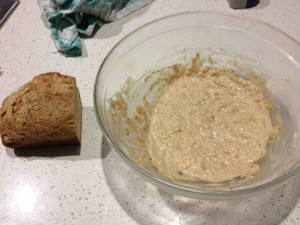I hate generalizations but if I was going to generalize, I would borrow from Amy and say Australians are all very nice.
Nice doesn’t get things done.
Which is why there’s talk of me being elected chair tonight of our four-townhome body corporate or homeowner’s association or whatever they’re called, because I’m the biggest a-hole they know.
We’ll be hosting the meeting, because it’s easier on the kid – and we’re the only ones with a kid – and because we don’t get invited anywhere;  people get antsy about that food safety thing.
people get antsy about that food safety thing.
I’ve got some whole wheat flour that’s been soaking overnight that I’ll make into bread later today, and like any raw ingredient, I treat flour as hazardous waste.
People may not think raw flour and foodborne illness, but it happens.
According to a new paper in Foodborne Pathogens and Disease, a cluster of salmonellosis cases caused by Salmonella Typhimurium phage type 42 (STM42) emerged in New Zealand in October 2008. STM42 isolates from a wheat-based poultry feed raw material (broll; i.e., product containing wheat flour and particles of grain) had been identified in the 2 months prior to this cluster.
Initial investigations indicated that eating uncooked baking mixture was associated with illness. A case-control study was conducted to test the hypothesis that there was an association between STM42 cases and consumption of raw flour or other baking ingredients. Salmonella isolates from human and non-human sources were compared using pulsed-field gel electrophoresis (PFGE) and multiple-locus variable number tandem repeat analysis (MLVA). Environmental investigations included testing flour and other baking ingredients from case homes, unopened bags of flour purchased from retail stores, and inspection of an implicated flour mill. A case-control study of 39 cases and 66 controls found cases had 4.5 times the odds of consuming uncooked baking mixture as controls (95% confidence interval [CI] 1.6–12.5, p-value 0.001). Examination of individual baking ingredients found that, after adjusting for eggs, flour had an odds ratio (OR) of 5.7 (95% CI 1.1–29.1, p-value 0.035). After adjusting for flour, eggs had an OR of 0.8 (95% CI 0.2–3.4, p-value 0.762). PFGE patterns were identical for all STM42 isolates tested; however, MLVA distinguished isolates that were epidemiologically linked to the cluster. STM42 was recovered from flour taken from four cases’ homes, two unopened packs purchased from retail stores and packs from three batches of retrieved (recalled) product. This outbreak was associated with the consumption of uncooked baking mixture containing flour contaminated with STM42. The implicated flour mill initiated a voluntary withdrawal from sale of all batches of flour thought to be contaminated. Media releases informed the public about implicated flour brands and the risks of consuming uncooked baking mixture.
